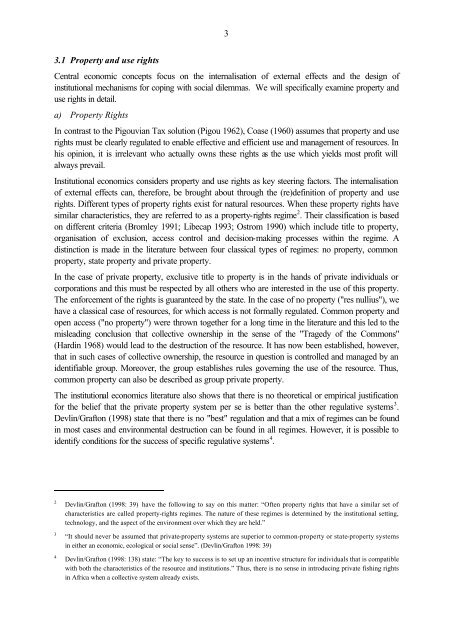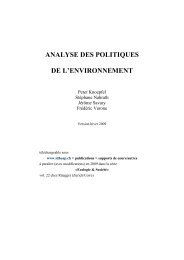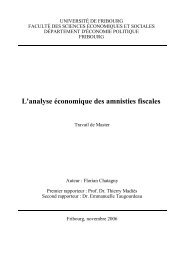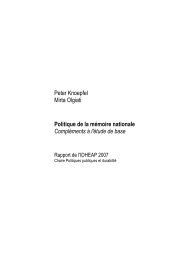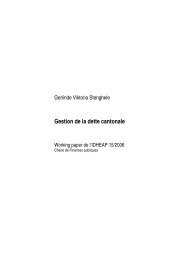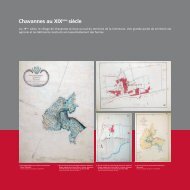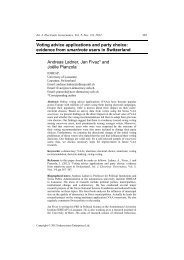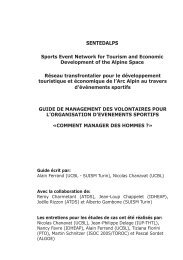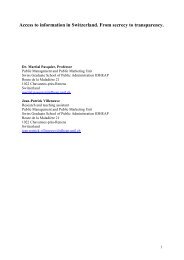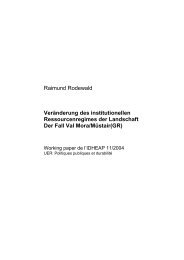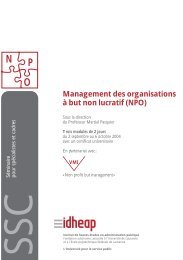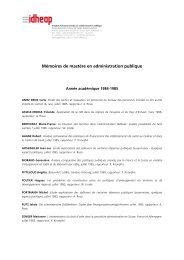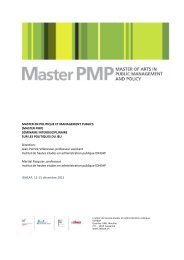Historical Analysis of Institutional Regimes in Switzerland ... - IDHEAP
Historical Analysis of Institutional Regimes in Switzerland ... - IDHEAP
Historical Analysis of Institutional Regimes in Switzerland ... - IDHEAP
You also want an ePaper? Increase the reach of your titles
YUMPU automatically turns print PDFs into web optimized ePapers that Google loves.
3<br />
3.1 Property and use rights<br />
Central economic concepts focus on the <strong>in</strong>ternalisation <strong>of</strong> external effects and the design <strong>of</strong><br />
<strong>in</strong>stitutional mechanisms for cop<strong>in</strong>g with social dilemmas. We will specifically exam<strong>in</strong>e property and<br />
use rights <strong>in</strong> detail.<br />
a) Property Rights<br />
In contrast to the Pigouvian Tax solution (Pigou 1962), Coase (1960) assumes that property and use<br />
rights must be clearly regulated to enable effective and efficient use and management <strong>of</strong> resources. In<br />
his op<strong>in</strong>ion, it is irrelevant who actually owns these rights as the use which yields most pr<strong>of</strong>it will<br />
always prevail.<br />
<strong>Institutional</strong> economics considers property and use rights as key steer<strong>in</strong>g factors. The <strong>in</strong>ternalisation<br />
<strong>of</strong> external effects can, therefore, be brought about through the (re)def<strong>in</strong>ition <strong>of</strong> property and use<br />
rights. Different types <strong>of</strong> property rights exist for natural resources. When these property rights have<br />
similar characteristics, they are referred to as a property-rights regime 2 . Their classification is based<br />
on different criteria (Bromley 1991; Libecap 1993; Ostrom 1990) which <strong>in</strong>clude title to property,<br />
organisation <strong>of</strong> exclusion, access control and decision-mak<strong>in</strong>g processes with<strong>in</strong> the regime. A<br />
dist<strong>in</strong>ction is made <strong>in</strong> the literature between four classical types <strong>of</strong> regimes: no property, common<br />
property, state property and private property.<br />
In the case <strong>of</strong> private property, exclusive title to property is <strong>in</strong> the hands <strong>of</strong> private <strong>in</strong>dividuals or<br />
corporations and this must be respected by all others who are <strong>in</strong>terested <strong>in</strong> the use <strong>of</strong> this property.<br />
The enforcement <strong>of</strong> the rights is guaranteed by the state. In the case <strong>of</strong> no property ("res nullius"), we<br />
have a classical case <strong>of</strong> resources, for which access is not formally regulated. Common property and<br />
open access ("no property") were thrown together for a long time <strong>in</strong> the literature and this led to the<br />
mislead<strong>in</strong>g conclusion that collective ownership <strong>in</strong> the sense <strong>of</strong> the "Tragedy <strong>of</strong> the Commons"<br />
(Hard<strong>in</strong> 1968) would lead to the destruction <strong>of</strong> the resource. It has now been established, however,<br />
that <strong>in</strong> such cases <strong>of</strong> collective ownership, the resource <strong>in</strong> question is controlled and managed by an<br />
identifiable group. Moreover, the group establishes rules govern<strong>in</strong>g the use <strong>of</strong> the resource. Thus,<br />
common property can also be described as group private property.<br />
The <strong>in</strong>stitutional economics literature also shows that there is no theoretical or empirical justification<br />
for the belief that the private property system per se is better than the other regulative systems 3 .<br />
Devl<strong>in</strong>/Grafton (1998) state that there is no "best" regulation and that a mix <strong>of</strong> regimes can be found<br />
<strong>in</strong> most cases and environmental destruction can be found <strong>in</strong> all regimes. However, it is possible to<br />
identify conditions for the success <strong>of</strong> specific regulative systems 4 .<br />
2<br />
3<br />
4<br />
Devl<strong>in</strong>/Grafton (1998: 39) have the follow<strong>in</strong>g to say on this matter: “Often property rights that have a similar set <strong>of</strong><br />
characteristics are called property-rights regimes. The nature <strong>of</strong> these regimes is determ<strong>in</strong>ed by the <strong>in</strong>stitutional sett<strong>in</strong>g,<br />
technology, and the aspect <strong>of</strong> the environment over which they are held.”<br />
“It should never be assumed that private-property systems are superior to common-property or state-property systems<br />
<strong>in</strong> either an economic, ecological or social sense”. (Devl<strong>in</strong>/Grafton 1998: 39)<br />
Devl<strong>in</strong>/Grafton (1998: 138) state: “The key to success is to set up an <strong>in</strong>centive structure for <strong>in</strong>dividuals that is compatible<br />
with both the characteristics <strong>of</strong> the resource and <strong>in</strong>stitutions.” Thus, there is no sense <strong>in</strong> <strong>in</strong>troduc<strong>in</strong>g private fish<strong>in</strong>g rights<br />
<strong>in</strong> Africa when a collective system already exists.


